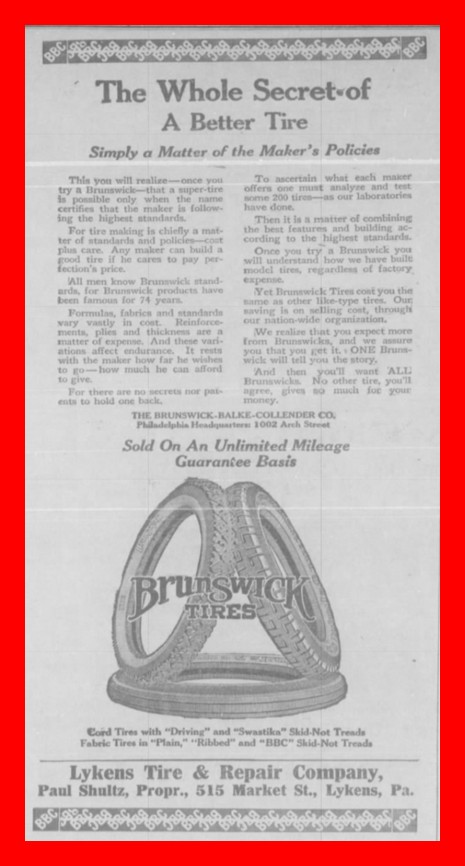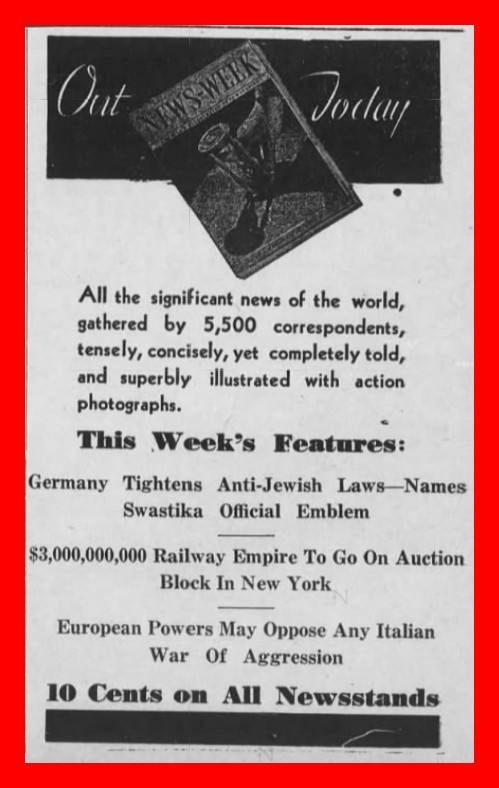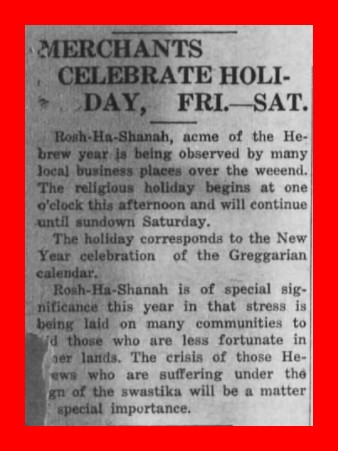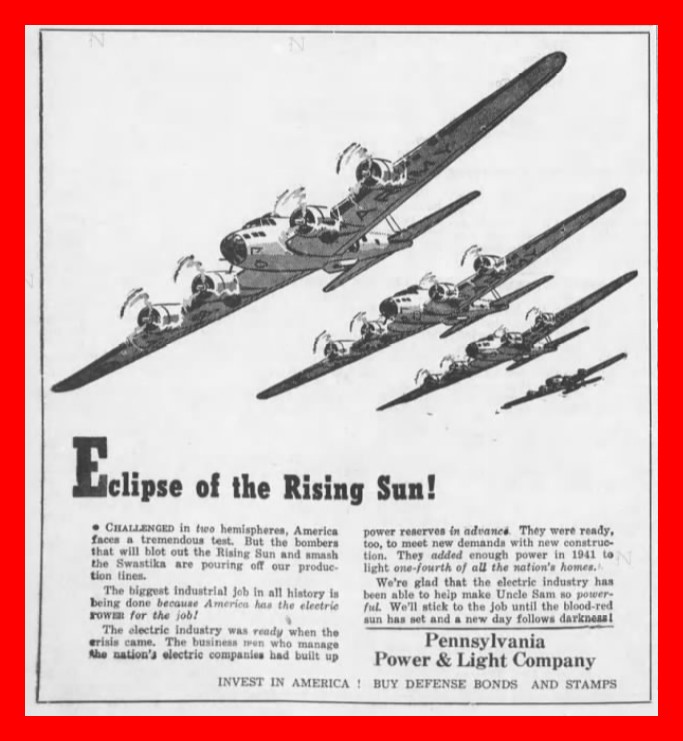On July 20, 1920, an appeared in the Lykens Standard for the Lykens Tire and Repair Shop, Paul Shulz, proprietor, 515 Market Street, Lykens, Dauphin County, Pennsylvania, in which the design of the tread of Brunswick Tires, was referred to as a “Swastika.” At the time, the symbol did not have an ignominious meaning or cause the same kind of repulsive reaction that it does today.
This post looks at how the swastika was described in the local press, mainly the Elizabethville Echo and Lykens Standard, from about 1915 through World War II, 1945.
The earliest article found describing the origin and meaning of the swastika is from the Elizabethville Echo of May 20, 1915:
The Swastika
The original place and significance of the “Swastika” sign are alike unknown, various theories having been put forward, in answer to both questions. It is certain, however, that the symbol has been known for centuries, and in prehistoric times, in various parts of the world, as an emblem of benediction, or good luck. The word is from the Sanskrit and means “weal-making.” The four-branched mono-grammatic sign has been found in Europe, Asia and America. It was known first in the bronze age, and it occurs in the Swiss lake dwellings. In the historic period it is found in Japan, Korea, China, Tibet, Armenia, Asia Minor, Greece and its islands, especially Cyprus and Rhodes; Italy, France, Germany, Scandinavia, Great Britain — perhaps only under Scandinavian influence — Ohio, Tennessee, Mississippi, Alaska, Mexico, and Brazil. It was not known in early India, and it is not known to be native to Egypt, Babylonia, Assyria, Phoenicia, or, till a late date, Persia. It was particularly adopted by Buddhism, and its presence in China and Tibet is thus explained. Its origin as a symbol has been the object of endless speculation; some scholars say it is a solar symbol; others and earth symbol, wind symbol, etc.; others that it is merely decorative in its origin. The cross, the lotus petal, the circle, etc., have been suggested as derivations for its form. It is probably chiefly talismanic.
_______________________________________
After the swastika was adopted by the German National Socialist Party, and one year before it became the national symbol of Germany, the Elizabethville Echo made another attempt to explain it historic origin. From September 27, 1934:
SWASTIKA: SYMBOL ORIGIN IN DOUBT
Some scholars believe the swastika is merely a decorative of ornamental design, having evolved from the lotus petal pattern used in early architecture. Some say it was merely a talisman or charm, to be worked in precious metals and worn as amulet or pendant.
As a mystic symbol, it is said to have been associated through the ages with fire, water, wind and rain. There are archeologists who hold that its four points, or feet, indicate the four cardinal points of the compass. It has been interpreted as representing a flame or sacred fire, the sun in its daily rotation and a flash of lightning. Much speculation followed its adoption as the national emblem of the German Socialist party several years ago and many articles were written about it. However, its real origin and first significance are still uncertain.
The final word on the swastika comes from the curator of archeology of Smithsonian Institution. “It is the earliest known symbol or form of the cross and is undoubtedly prehistoric. The name is Sanskrit, but the symbol existed long before it even had a name.?
___________________________________________
The Lykens Standard, over two years earlier on March 17, 1933, made an attempt to educate its readers on the meaning of the swastika:
Mascot for Happiness
The swastika is credited with being the oldest as well as the most powerful mascot in existence. The sign been found in ancient rock carvings in India, China, Japan and elsewhere, and on stone implements belonging to the very earlies races of mankind. The belief that it attracted good fortune arose from the fact that it was used by the ancients as the emblem of the sun. All the ancient races worshipped the sun, and the emblem was supposed to attract to the person who wore it, a big share of the sun’s favor. The name swastika is Sanskrit, and means “happiness.”
___________________________________________
A wire service story was printed in the Lykens Standard on September 13, 1935 about the reaction to the tearing down of a swastika flag on a German ship in the New York Harbor and a trial that took place in that city.
JUDGE SEES A PIRATE FLAG
New York City, New York — Last July in New York a Communist mob rioted on the Hapag-Lloyd liner Bremen and tore down the Nazi swastika flag. Germany instantly protested; the United States replied the offenders would be duly tried in New York. The rioters came before Magistrate Louis Brodsky. Finding no evidence that they had conspired to assemble unlawfully, the Jewish Magistrate discharged them, and in doing so paid his respects to the swastika banner — “The prominent display of this emblem even carried with it the same sinister implications as a pirate ship with the black flag of piracy proudly flying aloft.” The Nazi press: “Unheard of Insult to Nazi Germany! Shameless Verdict!” German’s Embassy filed protest.
____________________________________________
A week later, in another wire service story, the Lykens Standard (September 20, 1935) reported the newly instituted anti-Jewish decrees and the official adoption by Germany of the swastika as its official emblem – attributing both to the decision of a Jewish American judge in New York City.
SWASTIKA GERMANY’S EMBLEM
Berlin — Accompanied by sweeping anti-Jewish decrees, imposing social status of the Middle Ages on German Jews, depriving them of all rights as German citizens, the Swastika was adopted as the Reich’s official emblem, “Anti-Jewish Symbol of the World.” It is believed that the adoption of Swastika emphasizes the Nazi resentment of New York Magistrate Brodsky’s characterization of the emblem as the “black flag of piracy.”
_____________________________________
Readers of the Lykens Standard on September 20, 1935, could also read an advertisement for Newsweek to purchase its latest issue which would explain further the anti-Jewish laws and the adoption of the swastika.
Out Today
All the significant news of the world, gathered by 5,500 correspondents, tensely, concisely, yet completely told, and superbly illustrated with action photographs.
This Week’s Features
Germany Tightens Anti-Jewish Laws — Names Swastika Official Emblem
$3,000,000,000 Railway Empire To Go On Auction Block in New York
European Powers May Oppose Any Italian War of Aggression
10 Cents on All Newsstands
___________________________________________
The local reaction to the German crack-down was swift. In the Lykens Standard of September 27, 1935, the celebration by local businesses of the Jewish holiday of Rosh Hashanah was noted and connected to the plight of “those who are less fortunate in other lands” who are “suffering under the sign of the swastika.”
MERCHANTS CELEBRATE HOLIDAY, FRIDAY – SATURDAY
Rosh-Ha-Shanah, acme of the Hebrew year is being observed by many local business places over the weekend. The religious holiday begins at one o’clock this afternoon and will continue until sundown Saturday.
The holiday corresponds to the New Year celebration of the Greggarian [sic] calendar.
Rosh-Ha-Shanah is of special significance this year in that stress is being laid on many communities to aid those who are less fortunate in other lands. The crisis of those Hebrews who are suffering under the sign of the swastika will be a matter of special importance.
_______________________________________
Prior to the beginning of World War II in Europe, another attempt was made by the Lykens Standard to explain the “art” in Oriental rugs, some of which had a swastika in the design. Apparently, many people in the Lykens Valley were finding swastikas in their rugs. From April 22, 1938, this article by Betty Wells, of WNU Service, which did little to comfort those who may have been disturbed upon finding in their homes what now had become the symbol of the Nazis :
The Art in Oriental Rugs
If you find a swastika in your Oriental rug, don’t get excited. For it’s not Nazi propaganda at all — only one of the favorite motifs of Oriental rug weavers through many a century. No one knows when it first turned up in the dim reaches of antiquity, but it has permeated every civilization, every country. Some scholars call it the first conscious design of man. That is, almost anyone might have hit upon a circle of a square or an oval quite by accident. But it took conscious planning to created the crossed arms of the swastika.
Even the material of which Oriental rugs are made have a romantic lore clinging about them. The rug countries, reaching far north of the Russian border and from the Mediterranean to the Great Wall of China, are peculiarly suited to the arts of their people. For the fine grazing lands here are the main reason for their being known as the “Rug” countries. The lands provide just the right grasses and roots to make sheep and goats produce just the right wool for rugs.
As for the color in Oriental rugs, well that’s a sentimental tale in itself. For there is one man in the world who considers it an honor to be bedaubed. He is the dyer in an eastern rug country, one of the most honored men in his community. The dyeing of wools for rug-making is an ancient and guarded art. Each village or tribe has its various dyers and each dyer has his own range of colors to produce. The most important dyer is the producer of red. From the fields he gathers flowers, plants, herbs, shrubs, and by some mysterious alchemy he mixes and pours and boils and the wool is dipped into many pots before the color is just right. Sun has a great deal to do with his art and he knows to the minute just how ling to leave the drying skeins in the sunlight to produce just the right tone he wants.
____________________________________________
The two newspapers then went silent with the word “swastika” until the war was underway. On successive days in the last week of March 1942, the Elizabethville Echo and Lykens Standard published an advertisement for Pennsylvania Power and Light Company in which Germany and Japan were referred to as the “Swastika” and the “Rising Sun.”
Eclipse of the Rising Sun!
Challenged in two hemispheres, America faces a tremendous test. But the bombers that will blot out the Rising Sun and squash the Swastika are pouring off our production lines.
The biggest industrial job in all history is being done because America has the electric power for the job!
The electric industry was ready when the crisis came. The business men who manage the nation’s electric companies had built up power reserves in advance. They were ready, too, to meet new demands with new construction. They added enough power in 1941 to light one-fourth of all the nation’s homes.
We’re glad that the electric industry has been able to help make Uncle Sam so powerful. We’ll stick to the job until the blood red sun has set and a new day follows darkness.
Pennsylvania Power and Light Company
INVEST IN AMERICA: BUY DEFENSE BONDS AND STAMPS
__________________________________________________
The last-found reference to a swastika came on October 27, 1944, when the Lykens Standard reported that a Wiconisco soldier mailed some war booty back to his parents.
RECEIVES GERMAN FLAG FROM SON IN BELGIUM
Mr. and Mrs. David F. Alvord, Pottsville Street, Wiconisco, have received a large German flag from their son, Pfc. Don Alvord, who is now stationed in Belgium. The flag is 6 x 8 feet long, is of bright red, with a large white circle in the center inside the circle is a black swastika.
Pfc. Alvord entered the Army in February 1943. He is in the 26th Infantry of the 1st Division. After three months training he was sent overseas. When he first landed on foreign soil he was stationed in North Africa and took part in the Sicilian and Italian campaigns. His next assignments were in England, France and Belgium where he was last stationed when heard from.
He is 24-years old and a graduate of Wiconisco High School, Class of 1938. Before entering the Army he was employed in the Enola railroad yards.
Another son, Pvt. Carl Alvord is now stationed in France.
________________________________________________
News articles from Newspapers.com.
Corrections and additional information should be added as comments to this post.



